1. Music Video: Ghost Town
2. Music Video: Letter to the Free
3. On-line Marketing: Maybeline campaign
4. Film: Chicken
5. Radio: War of the Worlds
6. Radio: Life Hacks
7. Newspaper: Daily Mail
8. Newspaper: The i
9, Advertising (print): Score
+ there will be 1 x unseen product (= 10 CSP’s)
Theories to learn
> Semiotics
> Genre
> Narrative
> Postcolonialism
> Representation
> Feminist Critical thinking
> Liberal Free Press
> Transformation of Public Sphere
> PSB
> Ideology
> Audience theories
> passive / active
> reception theory / theory of preferred reading
> Cultivation theory
> Culture, politics, history
> (Fandom / Moral Panic)
Theorists to learn
~ Barthes ~ Pierce ~ Saussure
~ Neale
~ Todorov ~ Propp ~ Levi-Strauss ~ Chatman ~ Freytag
~ Gilroy ~ Said ~ Fanon
~ Butler ~ Mulvey ~ Van Zoonen ~ Hooks
~ Habermas ~ Curran ~ Seaton ~ Livingston & Lunt ~ Hesmondhalgh
~ Gerbner ~ Hall ~ Lasswell ~ Lasarzfeld ~ Shirky ~ Jenkins
~ Giddens ~ Gauntlett
~ McDougall / Fenton
Daily Mail story to reference:
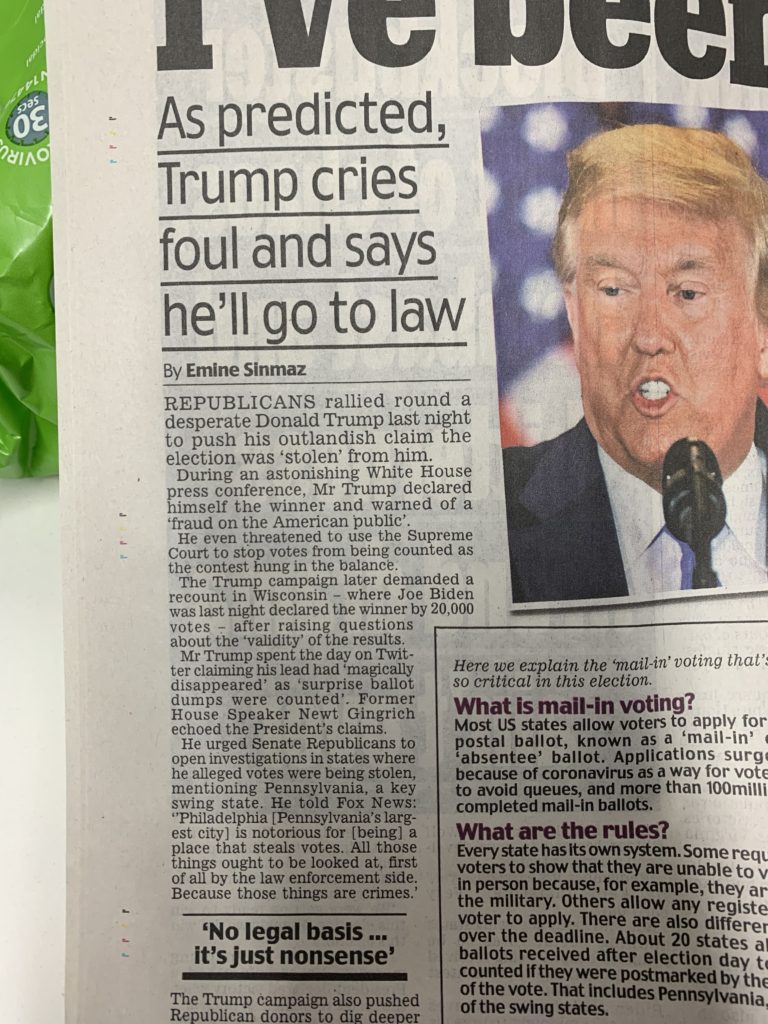
The i story to reference:
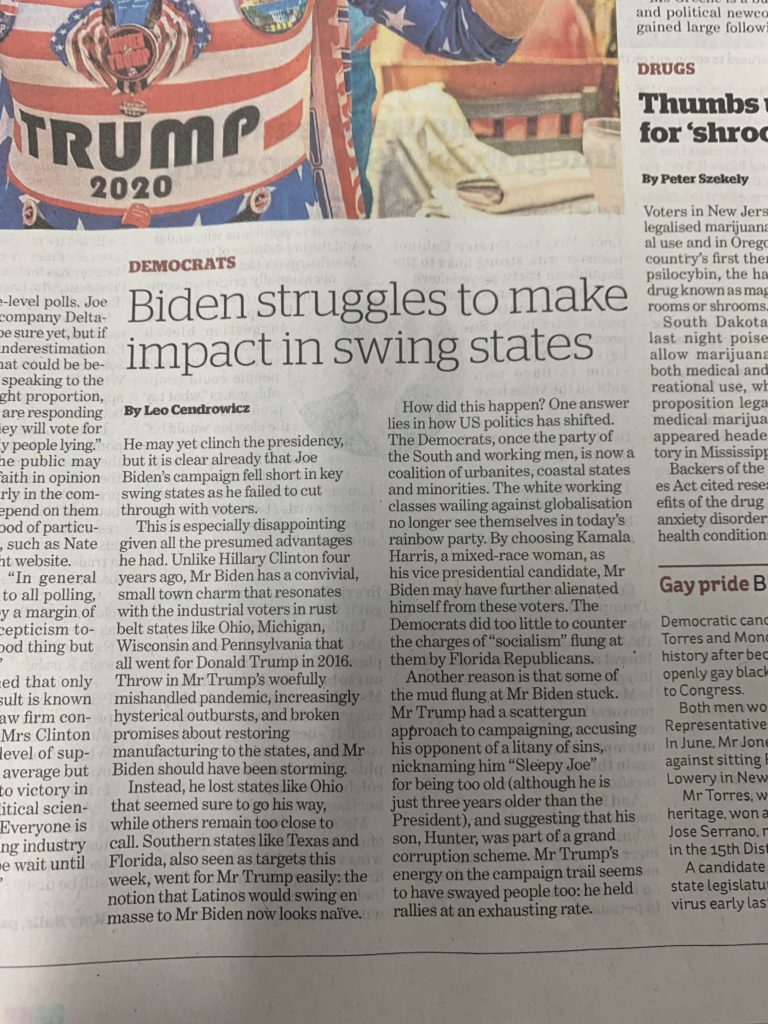
Advertising and Marketing – Score pre-1970 product.
This is a targeted CSP and needs to be studied with reference to two elements of the Theoretical Framework (MEDIA LANGUAGE and MEDIA REPRESENTATION) and all relevant contexts.
TASK 1: look at the CSP below and use some of the starting points provided to make your first post. Make this post broad and contextual (ie get as much information as you can) but divide up your responses in terms of: 1) MEDIA LANGUAGE & 2) MEDIA REPRESENTATION
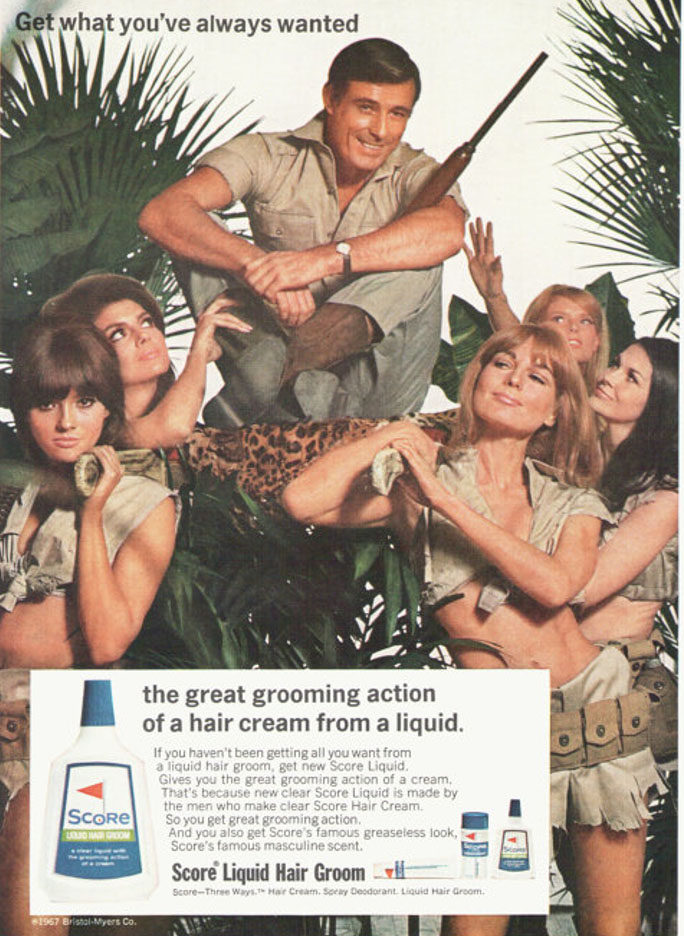
Media Language
Detailed study of Score should enable students to develop an understanding of the dynamic and changing relationships between media forms, products and audiences. Analysis should include:
- Mise-en-scene analysis
- Production values and Aesthetics
- Semiotics: how images signify cultural meanings
- How advertising conventions are socially and historically relative
- The way in which media language incorporates viewpoints and ideologies
Language-and-representation-SRPDOWNLOAD
Narrative
- How does Score construct a narrative which appeals to its target audience
- How and why audience responses to the narrative of this advert may have changed over time
- How does this advert create desire for the product
- Techniques of Persuasion
- Students should be able to demonstrate knowledge and understanding of the persuasive techniques used in the advert and issues surrounding brand values, brand message, brand personality and brand positioning should inform the analysis
Media Representations
Discussion of the Score advertisement will focus mainly on representation of gender including
- The processes which lead media producers to make choices about how to represent social groups
- How audience responses to interpretations of media representations reflect social, cultural and historical attitudes
- The effect of historical contexts on representations
- Theories of representation including Hall
- Theories of gender performativity including Butler
- Feminist theories including bel hooks and van Zoonen
- Theories of identity including Gauntlett
Historical, social and cultural contexts
The Score hair cream advert is an historical artefact from 1967, as such it can be examined productively by considering its historical, social and cultural contexts, particularly as it relates to gender roles, sexuality and the historical context of advertising techniques. 1967 can be seen as a period of slow transformation in western cultures with legislation about and changing attitudes to the role of women – and men – in society, something that the advert can be seen to negotiate.
Produced in the year of decriminilasiation of homosexuality the representation of heterosexuality could be read as signaling more anxiety than might first appear. The reference to colonialist values can also be linked to social and cultural contexts of the ending of Empire (see this link).
In comparison, Men’s Health magazine represents a notable social and cultural shift in expectations of contemporary masculinity (a shift which could be usefully compared with the advert for Score Hair cream). The study of Men’s Health can be linked to social and cultural contexts through reference to body image and changes in what society deems acceptable and unacceptable representations.
Similarly, comparisons with Maybelline campaign and Oh! magazine would be useful in exploring a range of different theoretical ideas and approaches: feminist critical thinking, postcolonialism, postmodernism.
The advertising techniques of fifty years could be compared to those of today. For example, references could be made with the Lynx Effect advert and the Specsavers adverts (both from 2010) which received criticism from the ASA, read this link or this link. And again reference to body image and changes in what society deems acceptable and unacceptable representations. So have ideas and acceptance around representation of gender really changed since the 1960’s?
CSP 8: THE I
In the exam, newspapers will feature in Section 3. Section 3 expects students to produce long answer questions about all four key theoretical areas of this course:
- Media Language
- Media Representation
- Media Audiences
- Media Institutions
If you haven’t seen this video (which was posted for CSP 7 TeenVogue, then watch it now, as there is a clear link between news, new media technologies, societies, politics, economics and individual lives.https://embed.ted.com/talks/carole_cadwalladr_facebook_s_role_in_brexit_and_the_threat_to_democracy
Task 1: New Technology and the News
Technology is central to any Media Studies course, and is of relevance in terms of news, newsgathering, production, distribution and consumption, as well as playing a significant role in terms of democracy, knowledge, access and truth. As a starter exercise to understand this relationship in terms of news production, create a table and see how many different technologies you can put in each box, to show which what technologies are used in each stage of the production process.
| Technology and Newspapers | ||
| Production | Distribution | Consumption |
| pen / pencil / paper word processor / printer telephone camera microphone license computer trees DTP data processors sources of information | (large scale) printing press lorries / vans / cars stacks / shelves / display cases / boxes social media platforms company / organisation / individual to deliver product storage billboards paper boys/girls target audience | paper (the ability to read? & understand?) a digital device (ipad/phone, computer reading glasses / eyes / braille / audio provision (headphones) WiFi target audience |
Media Institutions
So the link between new media technologies, corporate ownership and the media is . . . ‘Manufacturing Consent?’
Some such as theorist, academic and intellectual Noam Chomsky, that the media is a mechanism that is deliberately used by the rich and the powerful (the elite) as a way of ‘Manufacturing Consent’
If you want to a good documentary film that explores the way “uniformed electorate make irrational decisions” Chomsky, watch the film Get Me Roger Stone . .
Task 2: reading and thinking
“The link between media ownership of news organisations and news coverage is not easy to determine” which is briefly discussed and summarised in The Sociology of News Production by Michael Schudson.
Read this hand out and extract 3-4 short pithy quotes (that you could use in your exam answer) that helps to show your understanding and knowledge ie make sense to you. For example . . . .
- the suggestion that the news media ‘reinforces’ a political situation (Murdock, 1982), or the idea that
- ‘different stances different news organisations or types of organisations take toward different audiences in the marketplace‘ (Curran et al, 1980), or
- the proposition that “major media conglomerates control more and more of the world’s media. Where media are not controlled by organisations, they are generally voices of the state.”
- the propaganda model that the media ‘serve to mobilize support for the special interests that dominate the state and private activity‘ (Chomsky, 1988)
So how does this process of ‘manipulation’ or ‘persuasion’ work?
- Structures of ownership
- The role of advertising
- Links with ‘The Establishment’
- Diversionary tactics – ‘flack’
- Uniting against a ‘common enemy’
In another approach, we can suggest that the media are ‘agenda setting’, look at this powerpoint to understand what this could mean in terms of The i: AGENDA SETTING
AGENDA SETTING
FRAMING
MYTH MAKING
CONDITIONS OF CONSUMPTION
In summary, we need to be able to read the signs . . .
In other words, the media are biased!
In terms of setting an agenda and mapping a clear political bias watch the video below where anchors at Sinclair-owned local news stations parrot a script pushing Trump talking points and “the troubling trend of irresponsible, one sided news stories plaguing our country.
How can the Media act in the ‘Public Sphere’ in the ‘Public Interest’?
“a public space between the private domain and the state in which public opionion was formed and ‘popular’ supervision of government was established” (p. 82: 1996)
Task 3: Note taking
Look at the following extracts and note 5-10 bullet points that shows your understanding of ‘the public sphere‘ and the media as watchdog. Focus on what these terms mean and how did they emerge and develop. For example, in the extract: Mass Media and Democracy by James Curran there is a focus on Jurgen Habermas and his concept of the ‘Public Sphere‘,basically arguing that the developments in education and the mass media allowed for a greater access to information particularly with regard to government, authority and the exercise of control. Similarly, Denis McQuail aruges for a media that specifically works in the public interest and not in a purely commercial interest.

- Mass Media in the Public Interest (Denis McQuail)
- Mass Media and Democracy (James Curran) in the Public Service.
- For further reading and more in depth reflection look at this chapter from Brian McNair’s book Introduction to Political Communication (2011)
This links to the main proposition that we faced earlier in the academic year which was: in what ways are the culture industries different from other industries? Which was put forward in this extract from this opening chapter Culture Communication & Political Economy by Golding and Murdock from Mass Media and Society by James Curran and Michael Gurevitch,
A good starting point is to read this summary of James Curran and Jean Seaton’s work found on page 121 of the AQA Media Studies text book (Hendry & Stevenson), that highlights their 1997 book: Power without Responsibility (James Curran and Jean Seaton) .
“shows how different ways of financing and organising cultural production have traceable consequences for the range of discourses and representations in the public domain” (p.11: 1996)
Curran-Press-Freedom-2DOWNLOADSeaton-PSB-1DOWNLOAD
Perfect! All you need to know for an A level question about PSB. Really useful https://t.co/aGBfwK0hZM— McKiNlayMEdiA (@Mickinlay66) February 5, 2020
And our own ‘Political Bias’
Task 4: Complete the Political Compass Survey to give you an understanding of left / right . . . authoritarian / libertarian . . .
If news media (and other media forms?) exhibit bias, how can we identify and critically understand it? A good starting point may be to identify our own social-economic-political bias, so take this survey from ‘The Political Compass’ (link to test).
Post up the image of your results from the Political Compass and make some brief notes that show your understanding of left / right politics and authoritarian / libertarian forms of social control.
About the Political Compass
In the introduction, we explained the inadequacies of the traditional left-right line.







If we recognise that this is essentially an economic line it’s fine, as far as it goes. We can show, for example, Stalin, Mao Zedong and Pol Pot, with their commitment to a totally controlled economy, on the hard left. Socialists like Mahatma Gandhi and Robert Mugabe would occupy a less extreme leftist position. Margaret Thatcher would be well over to the right, but further right still would be someone like that ultimate free marketeer, General Pinochet.
That deals with economics, but the social dimension is also important in politics. That’s the one that the mere left-right scale doesn’t adequately address. So we’ve added one, ranging in positions from extreme authoritarian to extreme libertarian.
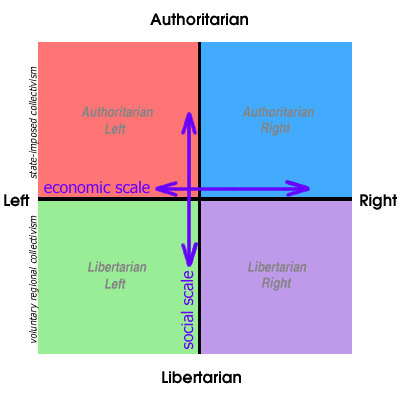
Both an economic dimension and a social dimension are important factors for a proper political analysis. By adding the social dimension you can show that Stalin was an authoritarian leftist (ie the state is more important than the individual) and that Gandhi, believing in the supreme value of each individual, is a liberal leftist. While the former involves state-imposed arbitrary collectivism in the extreme top left, on the extreme bottom left is voluntary collectivism at regional level, with no state involved. Hundreds of such anarchist communities existed in Spain during the civil war period
You can also put Pinochet, who was prepared to sanction mass killing for the sake of the free market, on the far right as well as in a hardcore authoritarian position. On the non-socialist side you can distinguish someone like Milton Friedman, who is anti-state for fiscal rather than social reasons, from Hitler, who wanted to make the state stronger, even if he wiped out half of humanity in the process.
The chart also makes clear that, despite popular perceptions, the opposite of fascism is not communism but anarchism (ie liberal socialism), and that the opposite of communism ( ie an entirely state-planned economy) is neo-liberalism (ie extreme deregulated economy)
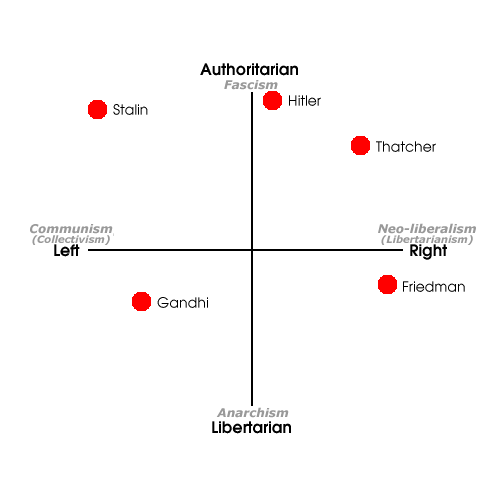
The usual understanding of anarchism as a left wing ideology does not take into account the neo-liberal “anarchism” championed by the likes of Ayn Rand, Milton Friedman and America’s Libertarian Party, which couples social Darwinian right-wing economics with liberal positions on most social issues. Often their libertarian impulses stop short of opposition to strong law and order positions, and are more economic in substance (ie no taxes) so they are not as extremely libertarian as they are extremely right wing. On the other hand, the classical libertarian collectivism of anarcho-syndicalism ( libertarian socialism) belongs in the bottom left hand corner.
In our home page we demolished the myth that authoritarianism is necessarily “right wing”, with the examples of Robert Mugabe, Pol Pot and Stalin. Similarly Hitler, on an economic scale, was not an extreme right-winger. His economic policies were broadly Keynesian, and to the left of some of today’s Labour parties. If you could get Hitler and Stalin to sit down together and avoid economics, the two diehard authoritarians would find plenty of common ground.
A Word about Neo-cons and Neo-libs
U.S. neo-conservatives, with their commitment to high military spending and the global assertion of national values, tend to be more authoritarian than hard right. By contrast, neo-liberals, opposed to such moral leadership and, more especially, the ensuing demands on the tax payer, belong to a further right but less authoritarian region. Paradoxically, the “free market”, in neo-con parlance, also allows for the large-scale subsidy of the military-industrial complex, a considerable degree of corporate welfare, and protectionism when deemed in the national interest. These are viewed by neo-libs as impediments to the unfettered market forces that they champion.

Task 5: Apply the theory to the CSP
Now you have a better understanding of left / right; authoritarian/libertarian forms of government and control, let’s apply the CSP / The i.
Use some of the questions from the survey that you have just taken from The Political Compass and link them to specific examples to the CSP (below).
Set out your approach ie your questions and the examples in a table.
Once you have produced enough data, see if you can plot the compass position of The i (based only on the 3 pages of our CSP.
As an alternative or more refined approach, take the whole test from the perspective of The i.
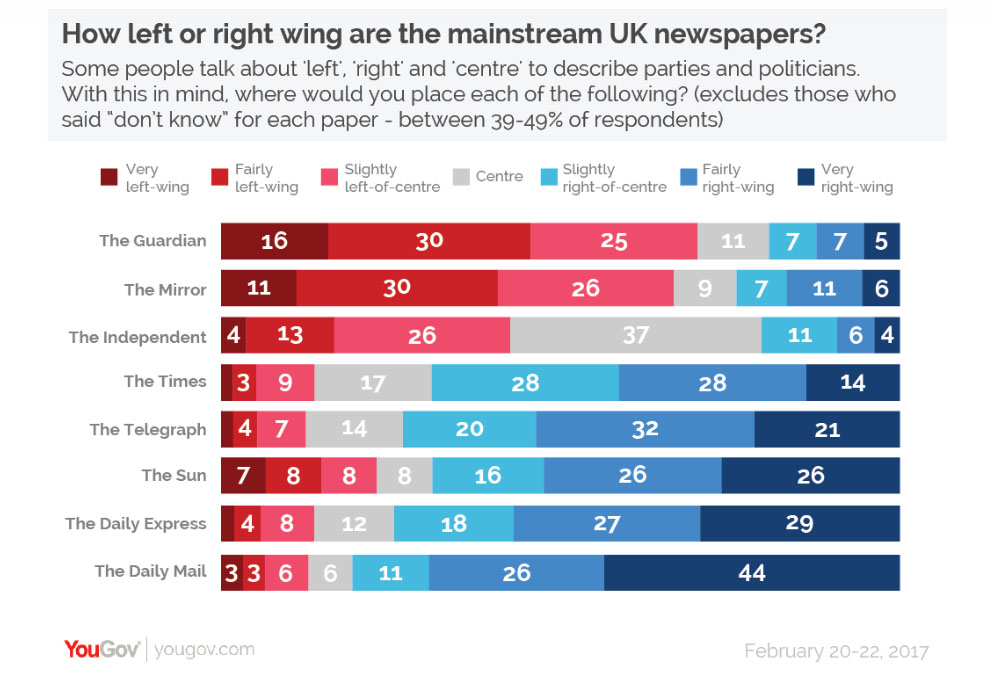

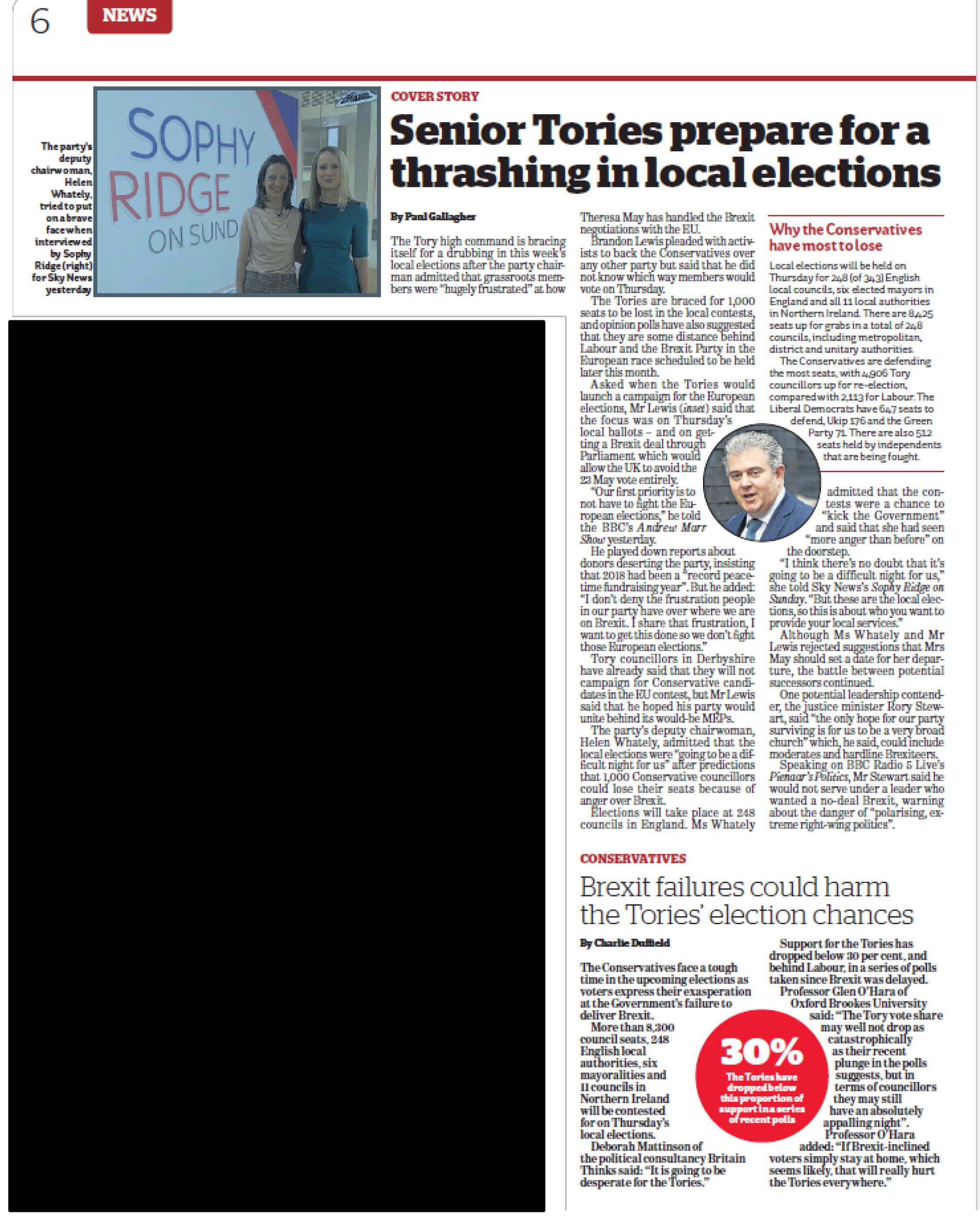
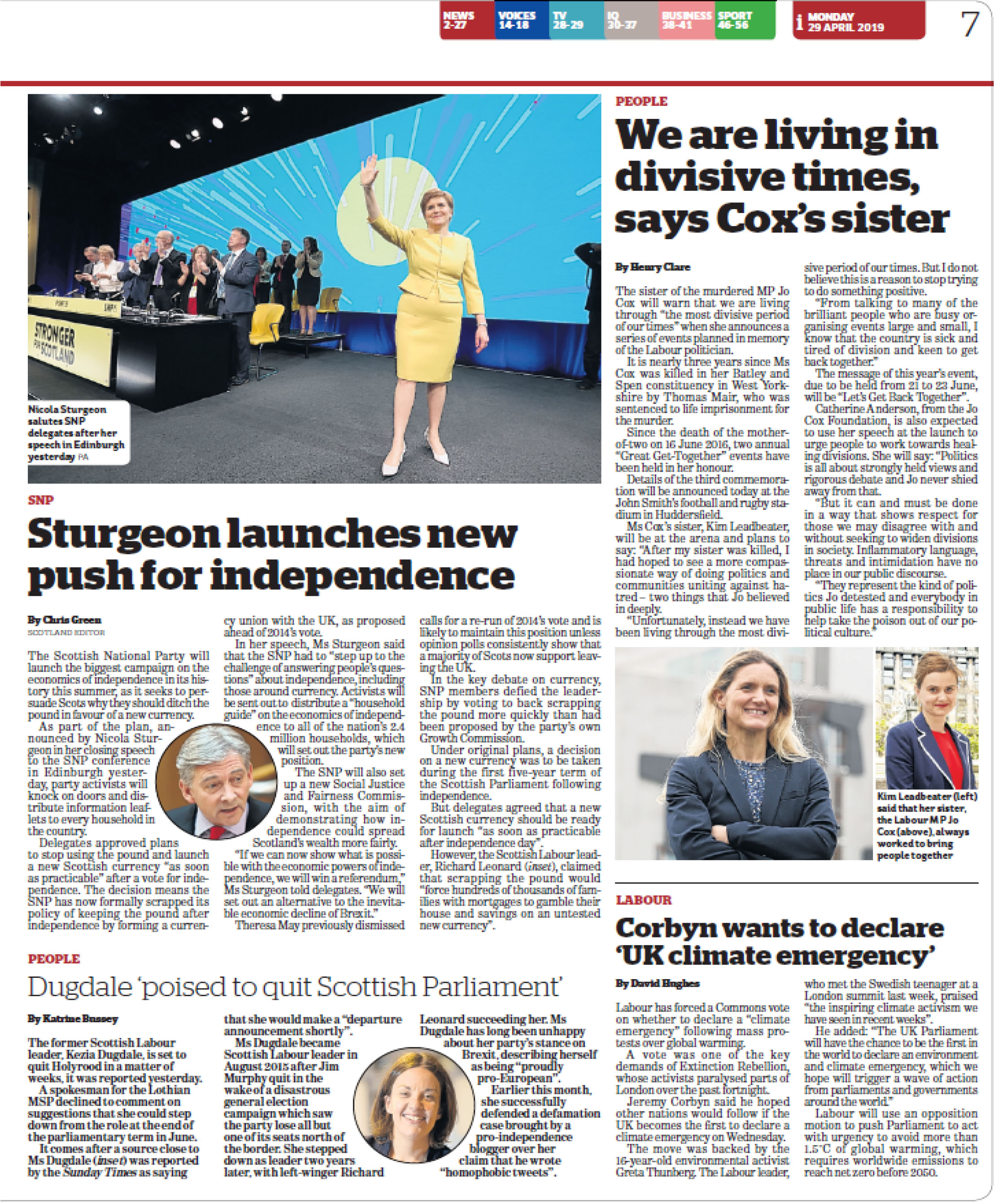
Summing up this CSP
Overall, in this section students are aiming to develop enough knowledge to show understanding of most of the following:
- patterns of ownership and control, including conglomerate mergers, vertical / horizontal integration and diversification
- the impact of economic factors, including commercial and not-for-profit aims and intentions
- the processes of production, distribution and circulation
- the role played by keyorganisations, groups and individuals in a global context
- how media organisations maintain, varieties of audiences nationally and globally
- recent technological change in terms of production, distribution and circulation
- patterns of consumption and response in terms of new media technologies
- the impact of ‘new’ digital technologies on media regulation, including the role of individual producers
- the regulatory framework of contemporary media in the UK
Task 6: Define these key terms
Now that we have developed an overall understanding, it is time to define and make notes on some key terms that you will need to know for your exam.
- News Values
- Gatekeepers
- Regulation / Deregulation
- Free market vs Monopolies & Mergers
- Media concentration / Conglomerates / Globalisation (in terms of media ownership)
- Vertical Integration & Horizontal Integration
- Neo-liberalism and the Alt-Right
- Surveillance / Privacy / Security / GDPR
- The Leveson Enquiry
- The Cairncross Review (read these questions under consideration: Caincross_call_for_evidence_govuk)
As a final point for this CSP make sure you facts and figures are in place . . .
Task 7: Find 10 Facts about The i
Build up evidence (ie KNOWLEDGE), for example, find some information about:
- History,
- Format,
- Editors,
- Political stance,
- Target Audience,
- Cost,
- Circulation,
- Profit
- etc
Note that the previous owners of The i – Johnston Press were up for sale and were bought out by JPI Media, read this article and that this ownership has recently changed through the acquisition and merger by the Daily Mail group https://www.bbc.co.uk/news/business-50598506 and https://www.theguardian.com/media/2019/nov/29/daily-mail-owner-buys-the-i-newspaper
Or for a brief look at contemporary ownership and control read this BBC article that asks why Billionaires want to own the news?
Assessment
ASSESSMENT: Go to the Planner page/tab and choose either the 7571 Question Paper from 23rd May 2018 and answer question 8. Plan your answer, share your responses and collaborate with others to produce a complete and full answer. Look at the feedback assessment sheet below for starting points and areas that you could / should cover in your answer.
You will also need to specifically refer to Curran and Seaton, so please look at the references to Curran and Seaton in the feedback sheet (and presented below) and look to match these ideas with your own reading of the two texts provided below. The aim is to build up your own knowledge and understanding of Curran and Seaton as this should be central to your answer.
- ‘the United Kingdom regards press freedom as an absolute freedom.’ The government leaves it to the market forces to decide which press products survive’ (1992: 53).
- In the case of the press, with certain limited exceptions, no legal restriction is placed on the right to buy or launch a newspaper. (This ensures, in liberal theory, that the press is free, diverse and representative (Curran and Seaton 2003: 346-7).
- In this view of freedom of expression, it is the interests of the press, not of its readers nor of the subjects of its coverage, which are fundamental. (‘Free enterprise is a pre-requisite of a free press’)
- Based on the assumption that democracy is best served by the free exchange of ideas, for which freedom of expression is vital. (‘the best test of truth is the power of the thought to get itself accepted in the competition of the market’)
Newpaper-assessment-and-feedback-template.DOWNLOAD
DAILY MAIL & THE i (AS CSP)
In order to develop this knowledge and understanding, you should consider one complete print edition of the newspaper chosen by your teacher and selected key pages from the newspaper’s website, including the homepage and at least one other page
CONNECT NEWSPAPERS CSP TO 2020 US PRESIDENTIAL ELECTION
KEY DATE: US PRESIDENTIAL ELECTION TUESDAY 3rd NOVEMBER. A simple guide to the election can be found here
So most likely to use the editions on Wednesday 4th (provisional planning at present)
PRESIDENTIAL DEBATES: Sep 29, Oct 15 & Oct 22
The Right to Vote
- Who has the right to vote?
- Should everybody have the right to vote?
- Does everybody have the right to vote?
- Has everybody always had the right to vote?
- How to enable / disable the right to vote?
- How does that help: candidates, the electoral process, democracy?
- What should be the role of the media in covering an election in terms of voting rights?
THE ELECTORAL COLLEGE A SYSTEM THAT HIGHLIGHTS KEY STATES NEEDED FOR PRESIDENTIAL ELECTION
Current data on US Election polling & Interactive ‘Who will win the election‘ a good link that gives data on US elections
- Jurgen Habermas and the concept of the Public Sphere
- James Curran & Jean Seaton – the theory of the liberal free press
- Noam Chomsky – the 5 filters that manufacture consent
- Louis Althusser – interpellation & Ideological State Appraratus
- Antonio Gramsci – the concept of hegemony / hegemonic struggle
TASK 2: SKIM READ THE FOLLOWING 2 ARTICLES AND TAKE OUT 5 QUOTES FROM BOTH AUTHORS THAT HELP YOU TO UNDERSTAND: 1) THE THEORY OF THE LIBERAL FREE PRESS &2) THE ROLE OF PUBLIC SERVICE BROADCASTINGCurran-Press-Freedom-2DOWNLOADSeaton-PSB-1DOWNLOAD
THREE TYPES OF MEDIA OWNERSHIP

MEDIA AS A COMMODITY v MEDIA AS A PUBLIC GOOD

TRANSNATIONAL MEDIA CORPORATIONS: THE IMPACT OF GLOBALISATION
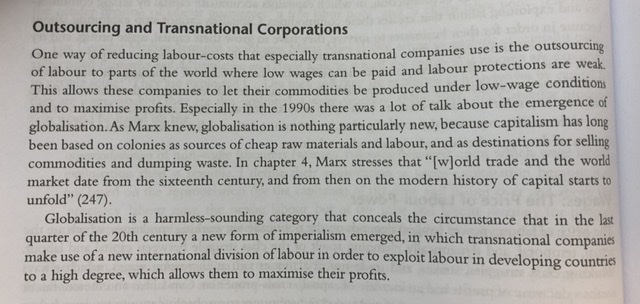
CSP 9: WAR OF THE WORLDS
03/18/2020DR MCKINLAYLEAVE A COMMENT
This is a Targeted Close Study product for which you will need to focus on the following areas of the Theoretical Framework:
> Media Industries
> Media Audiences
You will need to listen to excerpts from the broadcast but the main focus will be the technological development of radio as an institution.
War of the Worlds is an early example of a hybrid radio form, adapting the H.G Welles story using news and documentary conventions. The broadcast and the initial response to it has historical significance as an early, documented, example of the mass media apparently having a direct effect on an audience’s behavior. The academic research carried out into the broadcast (and the ongoing dispute about the extent of the effect) provided some of the early media audience research and the findings have been extremely influential in the media, advertising and political campaigning.
A useful overview and discussion of the context can be found here (not part of the CSP for assessment): https://www.wnycstudios.org/story/war-worlds
Media Institutions
War of the Worlds provides an historical context for broadcasting, being produced at a period when radio was the only form of domestic media; the 1930s and 1940s became known as the ‘golden age’ of radio.
- War of the Worlds was broadcast by Columbia Broadcasting Company – an institution still in existence (in a very different form) today.
- Radio broadcasting was seen as direct competition to newspapers which had previously been the only way of receiving news.
- The broadcast is typical of the way institutions are always looking for new styles in order to attract audiences.
- Regulation – radio broadcasting was regulated by the Federal Communications Commission and it investigated the broadcast to see if it had broken any laws.
- The broadcast provides an excellent example to consider the effect of individual producers on media industries (known as ‘auteur theory’) as this is the work of Orson Welles.
Media Audiences
War of the Worlds has become a real-world test case for a variety of audience theories, although the exact nature of the audience response is still disputed.
- What techniques (ie Media Language) does the broadcast use to convince the audience that what they’re hearing is really happening?
- Consider the way that external factors – global political context, gender, religion, education etc. – are likely to also affect audience response
- The ways in which audiences interpret the same media product differently – at the time of broadcast and now (Reception theory including Hall)
- Cultivation theory including Gerbner
Historical, political, social and cultural contexts
For many, the wider social, political, historical and cultural contexts are not just clearly connected to media studies but they are in some ways more important.
“I’ve always said you can’t understand the world without the media nor the media without the world” (Professor Natalie Fenton, quoted in Fake news vs Media Studies J. McDougall p.17 2019, Palgrave)
“I do spend long periods of time with my gaze turned away from the media, because I’m seeking to understand what’s going on out there, and then the role of the media in that context. I’m always putting the social, the political and the economic (contexts) first.” (ibid)
War of the Worlds can be considered in a historical context as it provides an interesting study of the power and influence of radio as a form during its early days of broadcasting. It is also useful to consider the product in a social, cultural and political context when considering audience responses to the programme. It was first broadcast on the eve of World War II and reflected fears of invasion in the US and concerns about international relations.
Some other thoughts regarding this text center around contemporary ideas of Fake News. In other words, do we / can we trust the media? Where do you get knowledge and information? It also a text that shows the power of the media, to influence vulnerable audiences. Although I wonder if the stories around audiences reacting passively as if it were a true story were exaggerated almost as a marketing exercise, that in itself is a form of made up information? Indeed, isn’t all information made up? How do we know what is truth? What is clear is that the distinction between fact and fiction is often blurred and relies upon audience members recognising and understanding specific codes and conventions that relate to each Media Language. In this instance, the Language of Radio is used creatively to structure a text that could be taken as fact, but is clearly fiction. Recognising the particular social and historical moment that this media text was produced is significant, so was this a comment on the ability of the mass media to create propaganda and manipulate a compliant and vulnerable mass audience? Is that still relevant today? Think about twitter, Trump, Brexit etc. If so, then Chomsky‘s argument that the media is used by powerful groups – ‘Manufacturing Consent‘ – is the most appropriate theory to structure an understanding of media, technology, control, manipulation and power.https://www.youtube.com/embed/Xs0K4ApWl4g?enablejsapi=1&autoplay=0&cc_load_policy=0&cc_lang_pref=&iv_load_policy=1&loop=0&modestbranding=0&rel=1&fs=1&playsinline=0&autohide=2&theme=dark&color=red&controls=1&
Other areas to think about (but unlikely to form part of your assessment)
Media Language
- War of the Worlds is a good case study for students to understand the way codes and conventions of radio drama (sound, dialogue, SFX, microphone technique, silence, words, accents, dialects etc) are put together to create meaning and construct a recognisable and familiar genre (Steve Neale). War of the Worlds also belongs to the genre of sci-fi and invasion – how are the conventions evident?
- But can War of the Worlds be considered as an intertextual product? Or pastiches of other genres.
- Consider how developing technologies affect media language: in 1938 radio was still a relatively new mass media technology, the broadcast could experiment with the form in a way not possible later on.
- At the time of the broadcast the idea of hybrid genres was unfamiliar, with clear boundaries between fact and fiction, making this a significant development in the form.
- War of the Worlds is a good case study for students to understand the way codes and conventions of radio drama (sound, dialogue, SFX, microphone technique, silence, words, accents, dialects etc) are put together to create meaning and construct a recognisable and familiar genre (Steve Neale). War of the Worlds also belongs to the genre of sci-fi and invasion – how are the conventions evident?
- But can War of the Worlds be considered as an intertextual product? Or pastiches of other genres.
- Consider how developing technologies affect media language: in 1938 radio was still a relatively new mass media technology, the broadcast could experiment with the form in a way not possible later on.
- At the time of the broadcast the idea of hybrid genres was unfamiliar, with clear boundaries between fact and fiction, making this a significant development in the form.
Media Representations
While there are representations of social and cultural groups in War of the Worlds, this broadcast is particularly significant for studying how a media product constructs a representation of reality, drawing on issues in society to convince the audience of its reality.
- How does the use of media language construct the representation of the real?
- Is this programme an early example of fake news?
- What signifiers of different groups and social classes are used?
- The representation of the alien invaders in sci-fi genre.
- As a broadcast in October 1938, can War of the Worlds be interpreted as representing particular political concerns to US – and international – society?
CSP 6: LETTER TO THE FREE – COMMON
Selection Criteria
Common is an Oscar and Grammy award winning hip/hop rap artist who wrote Letter to the Free as a soundtrack to The 13th – a documentary by Ava DuVernay named after the American 13th amendment (the abolition of slavery). His output is highly politicised, existing in the context of a variety of social and cultural movements aimed at raising awareness of racism and its effects in US society (e.g.: Black Lives Matter). The product can also be considered in an economic context through the consideration of if and how music videos make money (through, for example, advertising on YouTube).
Music Video – Letter to the Free is a product which possesses cultural and social significance. It will invite comparison with other music videos allowing for an analysis of the contexts in which they are produced and consumed.
If this CSP appears in the exam it will be in Section B: Industries and Audiences
What needs to be studied? Key Questions and Issues
This product relates to the theoretical framework by providing a focus for the study of:
Media Industries
The media of music video provides a useful case study to consider:
- how musicians and the wider industry have responded to rapid technological change – streaming, piracy, video hosting sites – finding ways to make money from previously free services.
- the significance of patterns of ownership and control, including conglomerate ownership, vertical integration and diversification
- the way new media products are distributed on youtube and across the internet by Vevo, a video hosting service.
- How artists are marketed and developed: Common is a Def Jam recording artist. Def Jam is a label associated with urban and hip hop music, starting as an independent in the 1980s it is now owned by the conglomerate UMG (which also owns Vevo)
- As the soundtrack to the Netflix documentary The 13th the video is an example of cross media promotion and marketing.
TASK 1: Create a new post that looks at:
- the artists involved (background, history, other work)
- the actual music video (style, genre, narrative, characters, theme, message, ideology etc)
- the institutions involved in this production (think again about majors vs indies, the role of conglomerates, vertical and horizontal integration, cross-media ownership, synergy, marketing & distribution, methods and modes of production and of course revenue).
- the audience who are targeted (the role of politics, identity and culture in terms of producing product for ‘the culture industries’). Remember to think about audience theory – particularly, the theory of preferred reading.
Points you could include:
- processes of production, distribution and circulation by organisations, groups and individuals in a global context
- the relationship of recent technological change and media production, distribution and circulation
- the impact of ‘new’ digital technologies on media regulation, including the role of individual producers.
- the significance of patterns of ownership and control, including conglomerate ownership, vertical integration and diversification
- the significance of economic factors, including commercial and not-for-profit public funding, to media industries and their products
- how media organisations maintain, varieties of audiences nationally and globally
- the interrelationship between media technologies and patterns of consumption and response
Key terms
- Gatekeepers
- Regulation / Deregulation
- Free market vs Monopolies & Mergers
- Media concentration / Conglomerates / Globalisation (in terms of media ownership)
- Vertical Integration & Horizontal Integration
- Surveillance / Privacy / Security
TASK 2: How many of these key words can you relate to the other CSP’s in Section B (ie TV & Film)? Do you need to look at your notes or adjust them in light of what you now know?
Media Audiences
The study of audiences for this video will use the analysis of media language and representation to consider how the video addresses an audience. As both rap and political protest song, the video can be studied as addressing a range of audiences beyond the youth market.
- How media producers target, attract, reach, address andpotentially construct audiences
- How media industries target audiences through the content and appeal of media products and through the ways in which they are marketed, distributed and circulated: widely distributed on video hosting sites aimed at a youth audience but also consumed by the audience for political documentary.
- How audiences interpret the media, including how they may interpret the same media in different ways (Hall Theory of Preferred Reading)
- Cultivation Theory
- Uses and Gratifications Theory
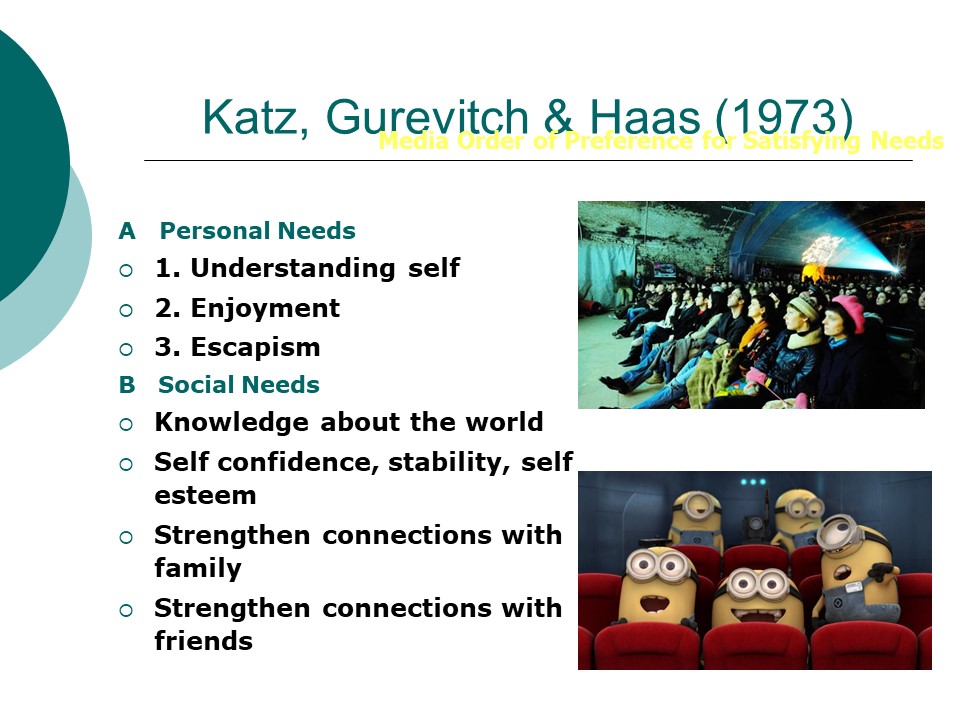
TASK 3: Complete another exam question – go to planner and Media Sams Paper 1, Question 7: Explain how the social, political and cultural contexts of media influence how audiences may interpret the same media in different ways. Use Common’s Letter to the Free to support your answer. Use the feedback document below to help your answer the question.Music-essay-assessment-and-feedbackDOWNLOADCommon-exemplar-essayDOWNLOAD
A possible structure to your essay could be:
- show your knowledge of the institutional details of the text ie specifics facts, figures, names, dates etc about the text. At this point show your knowledge of the music industry and use key terms (see above)
- Next, show how audiences may (theoretically) interpret media texts ie audience theory.
- Follow this up with specific ideas that suggest how certain audiences may interpret this particular text (ie apply the theory to this CSP)
- Finally, make some summative conclusions based on your knowledge and understanding that show the importance of culture in terms of engaging with issues of power and control. For this you could reference Gramsci & his concept of ‘hegemony’ and/or Habermas and his concept of ‘the public sphere’
Hegemony
Habermas ‘the public sphere’

CSP 10: MUSIC VIDEO
The Specials – Ghost Town
This is a targeted CSP and needs to be studied with reference to two elements of the Theoretical Framework (Media Language and Media Representation).
1TASK 1: MAKE SOME GENERAL NOTES ON THIS MEDIA PRODUCTION: NAMES, DATES, NUMBERS, ETC
Ghost Town is a product which possesses cultural, social and historical significance. It will invite comparison with the other CSP music video allowing for an analysis of the contexts in which they are produced and consumed.
2TASK 2: WHAT IS THE CULTURAL, SOCIAL AND HISTORICAL BACKGROUND IN WHICH THIS VIDEO WAS COMMENTING UPON?
Ghost Town by The Specials conveys a specific moment in British social and political history while retaining a contemporary relevance. The cultural critic Dorian Lynskey has described it as ‘’a remarkable pop cultural moment’’ one that “defined an era’’. The video and song are part of a tradition of protest in popular music, in this case reflecting concern about the increased social tensions in the UK at the beginning of the 1980s. The song was number 1 post-Brixton and during the Handsworth and Toxteth riots.
The aesthetic of the music video, along with the lyrics, represents an unease about the state of the nation, one which is often linked to the politics of Thatcherism but transcends a specific political ideology in its eeriness, meaning that it has remained politically and culturally resonant.
The representations in the music video are racially diverse. This reflects its musical genre of ska, a style which could be read politically in the context of a racially divided country. This representation of Britain’s emerging multiculturalism, is reinforced through the eclectic mix of stylistic influences in both the music and the video.
3TASK 3: MAKE SOME NOTES ON THE WAY IN WHICH THIS MUSIC VIDEOS CREATES AND COMMUNICATES MEANING IE MEDIA LANGUAGE.
You should adopt a SEMIOTIC ANALYSIS (ie the use of signs) which should specifically look at:
- Mise-en-scene – ie what can you see in each shot
- Cinematography – ie how does the camera frame each shot & how are the shots edited together
You should also adopt a NARRATIVE ANALYSIS
- How the story / narrative is constructed (this post should be helpful or this BBC Bitesize post)
- How TODOROV, LEVI-STRAUS & PROPP could be applied to this music video (you may remember that we looked at these on our AS TV CSP link here or on this narrative post on my blog
- Think about how the visuals link to the song lyrics (is it a LITERAL OR METAPHORICAL interpretation, eg the journey through a deserted landscape, or the way lyrics refer to effects of political and economic conditions)
- How audiences are positioned and invited to respond (do they use a direct mode of address?)
- How the Narrative structure provides appeal, interest and pleasures (think active audiences . . Uses and Gratifications theory or for those students who looked at my Easter post, apply the 2 Step Flow model (link here)
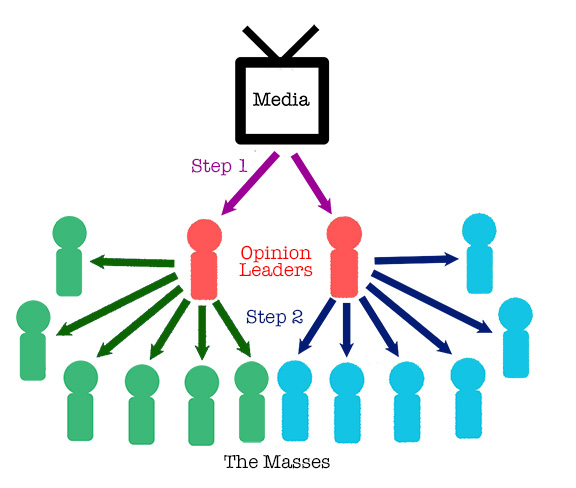
You should also focus on GENRE
- Make sure you reference Neale! You may remember that we looked at Steve Neale when we looked at AS TV CSP (link here)
- How the music video genre uses intertextuality and hybridity to establish meanings
- How music videos meet the expectations of audiences
ASSESSMENT
You have a choice from two A level essay questions: YOU ONLY NEED TO ANSWER 1 QUESTION and either email it to me or upload it to the blog, (but remember to let me know if you have done so). They are both A2 exam questions and they are both worth 12 marks. Mark schemes and feedback sheets are below. Further reading / sources of information at the bottom of this post. Good luck
Q1: How useful are ideas about narrative in analysing music videos? Refer to both CSP’s in your answer [12 marks]
Q2: Explain how representations used in Music Videos communicate information about their cultural and political contexts.A2-Music-Video-essay-CULTURE-POLITICS-assessment-and-feedbackDOWNLOADA2-Music-Video-essay-NARRATIVE-assessment-and-feedbackDOWNLOAD
Useful sources of information
- Directed by the graphic designer Barney Bubbles (there’s an interesting overview of his work at: https://daily.redbullmusicacademy.com/2015/03/barney-bubbles-feature
- Ska story: the sound of angry young England: (https://www.chicagoreader.com/chicago/skastory-the-sound-of-angry-young-england/Content?oid=875398)
- Reggae: the sound that revolutionised Britain (https://www.theguardian.com/music/2011/jan/30/reggae-revolutionary-bob-marley-britain)
- The Specials: How Ghost Town Defined an Era: https://www.bbc.co.uk/news/magazine-13780074
- Abigail Gardner (an academic specialising in pop music and the media) Ghost Town: A Haunting 1981 Protest Song That Still Makes Sense Today: https://theconversation.com/ghost-town-a-haunting-1981-protest-song-that-still-makessense-today-88733
- Alexis Petridis (Guardian music journalist) Ska for the madding crowd: The Specials and the story of the UK’s most remarkable chart-topper | Culture | The Guardian
- An overview of the different ways music videos can make money in the contemporary economic context is discussed in this article from the US Rolling Stone magazine: https://www.rollingstone.com/music/music-news/seven-ways-musicians-make-money-off-youtube192629/
CSP 15 ‘CHICKEN’
(Joe Stephenson, UK, 2014:)
Students are not required to watch the film for the assessment, but is available on both i-tunes (rent + purchase) & amazon prime (rent only).
The film should only be studied in relation to Media Industries, specifically the production and distribution context.
Film: Chicken is an example of micro budget film making and raises issues around the role and future of national cinema as well as the viability of media products produced outside of the
mainstream for niche audiences.
Students do not need to watch the film but will need to be familiar with the production context and distribution materials including:
- the official website, posters,
- trailer,
- social media presence (twitter, facebook etc).
- B Good Pictures: website, YouTube channel, twitter, facebook
Key Questions and Issues
• Identification of how Chicken is characteristic of an independent film release, with consideration of budget, distribution, circulation.
• Micro budget rather than low budget film (approximately £110,000) – entirely independent financing.
• Distribution techniques – reliance on new technology; VOD, streaming, audience ‘programming’ (open screen etc.)
• Continued use of traditional marketing and distribution; trailers, posters, film festivals etc.
• The concept of “risk-taking” in terms of narrative choice available to independent studios
• Regulation of the industry through BBFC (British Board of Film Classification).
• Regulation including Livingstone and Lunt
Social, economic and cultural contexts
Chicken is characteristic of contemporary cultural production in its use of new technology at production and distribution stages. Reflects shifting patterns of audience consumption. As a low budget film, it will be interesting to consider this film in its economic context, especially in comparison to big-budget Hollywood films.
Theoretical approaches
Chicken is characteristic of the ‘risky’ business of cultural production (Hesmondhalgh), £100K + is a lot of money for a single individual, without a guaranteed return. Chicken also represents diversity in media production (Curran and Seaton) as this film provides a voice and narrative to groups who are not necessarily represented in mainstream media. Henry Jenkins and David Gauntlett would acknowledge that web 2.0 enabled big businesses to exploit the web for commercial reasons, but would also argue that the internet remains the capacity to work as a social good and that online communities created via ‘participatory culture’ have the power to change the world for the better. Web 2.0 refers to websites that emphasize user-generated content, ease of use, participatory culture and interoperability for end users. Similarly, Clay Shirky argues that the media industry is increasingly driven by audience feedback systems rather than top-down control of proprieters. Read page 140 below. Media-ownership-Curran-and-SeatonDOWNLOAD
Note how there is a focus on making judgements and drawing conclusions in this essay
Release
Chicken had its world premiere on 27 June 2015 Edinburgh International Film Festival. The film had its international premiere in competition at the 2015 Busan International Film Festival, followed by screenings at the New Hampshire International Film Festival, Giffoni International Film Festival, Cine A La Vista International Film Festival, Tallinn Black Nights Film Festival, Schlingel International Film Festival and Dublin International Film Festival. It eventually received a limited theatrical release in the UK on 20 May 2016.
It was then acquired by MUBI UK, and had its British TV premiere on FilmFour April 2017. It received its DVD and Blu-ray release by Network on 18 September 2017.
Critical reception
- Chicken received positive reviews and holds a 100% “Certified Fresh” rating on Rotten Tomatoes based on 12 critic reviews.
- Leslie Felperin of The Guardian gave the film 3/5 stars and said “first-time director Joe Stephenson elicits lively, empathetic performances from his small cast.”
- Mark Kermode, also in a Guardian review, rated the film at four out of five stars stating that Scott Chambers’ performance is “superb”.
- Anna Smith of Empire magazine gave the film a rating of four stars, responding that the film is “an enjoyable, involving British Drama with and impressive turn from newcomer Scott Chambers.
- Cath Clarke of Time Out, commented that Chicken is “an impressively acted British Drama about a young man with learning difficulties.”
- CineVue praised the film and mentioned that it is “the sort of British indie which restores faith in cinema”.
Accolades
- Grand Jury Award for Narrative Feature — Joe Stephenson (New Hampshire Film Festival 2015)[2][9]
- Silver Griffoni Award for Best Film – Generation 18+ (2nd Prize) — Joe Stephenson & B Good Picture Company (Giffoni Film Festival 2016)[9]
- Award for Best Film — Chicken (Cine A La Vista International Film Festival 2016)[9]
- Scott Chamber’s performance as Richard got a Special Critic’s Circle mention (Dublin International Film Festival 2016)[9]
- The film was shortlisted for Best Director (Joe Stephenson) and Best Newcomer (Scott Chambers) by the British Independent Film Awards.
FURTHER READING
CSP 3: THE BOSS LIFE
For our next CSP (number 3 of 9) we are looking at the area of ADVERTISING AND MARKETING, in the exam, you may well be asked to respond to this set text in terms of MEDIA LANGUAGE AND/OR REPRESENTATION. This CSP will appear in Section A of your exam paper.
TASK 1: TECHNIQUES OF PERSUASION
As this is looking at advertising the first task is to think about (and make some notes on) the way in which advertising persuades a specifically targeted audience to consume its product. In terms of the expectations from the exam board:
Students should be able to demonstrate knowledge and understanding of the persuasive techniques used in the advert and issues surrounding brand values, brand message, brand personality and brand positioning should inform the analysis.
So please watch this advert a couple of times, discuss with your friends and be prepared to feedback your answers to the whole class, think specifically about the following questions:
- Think about how Maybelline created an advert for this product. What elements are used to make this advert? What media techniques are used in this advert?
- What is the brand message and what values does this hold for a modern audience? What makes this advert different?
Have a look at some of the following articles to help your understanding (and note-taking)
Maybelline Recruits Manny Gutierrez as Its First Male Beauty Star
You should also read page 15 of this Media Magazine ed 63 and you could try reading small sections of this academic paper called: Persuasive Techniques used in Marketing and Advertising, a thesis by Elizaveta Baryshnikova
Finally think about how you are going to feedback your ideas and share your notes.
Oh and also . . . don’t forget about how different audiences may interpret the same message in different ways . . . (remember? Stuart Hall and the Theory of Preferred Reading?)
The Language of Moving Image
It is possible to look at the Language of moving image from 2 perspectives 1) TECHNICAL CODES & 2) NARRATIVE. So firstly, make up a table that looks like the one below and in small groups fill in as much information as you can – you will need to watch the clip several times to do this. Upload the completed (shared) table to your blog. You may find this page useful: http://mymediacreative.com/blog/2019/04/20/language-of-moving-image-2/
| Technical Code | Denotation (ie what is it – simply describe what you see / hear) | Connotation (ie what does it signify) |
| Setting | ||
| Clothing | ||
| NVC | ||
| Dialogue | ||
| Sound Effect | ||
| Music | ||
| Camera shot size | ||
| Camera movement | ||
| Editing |
Next apply the following 3 narrative theories to the maybeline advert:
- Todorov’s Theory of Narrative Equilibrium
- Levi-Straus Theory of Binary Opposition
- Propp’s Theory of Narrative Characters Types
Again use a table to show your understanding. You may find this page useful: http://mymediacreative.com/blog/2019/04/22/narrative/
| Theorist | What does it mean (in your own words) | How does it apply to the advert (in your own words) |
| Equilibrium | ||
| Binary Opposition | ||
| Character Types |
THE EXAM
- Look at the exam papers on the planner page.
- Look at the section A.
- Section A is focused on LANGUAGE AND REPRESENTATION
- Section A looks at 3 CSP’s / Media forms:
advertising and marketing
magazines
video games
- That means we have finished this section!
- Therefore can you answer the questions from this section (if they were based on this year’s CSP’s? Mens Health, Tomb Raider, Maybelline)
PREPARATION FOR THE EXAM
If this CSP comes up in the exam you can expect your question to be based around discussion of the Maybelline advert mainly on representation of gender, age, ethnicity and lifestyle with opportunities for direct comparison with other advertising CSPs.
- The way the media through re-presentation constructs versions of reality
- How and why stereotypes can be used positively and negatively
- The processes which lead media producers to make choices about how to represent social groups
- How audience responses to interpretations of media representations reflect social, cultural and historical attitudes
- The effect of social and cultural contexts on representations
- Theories of representation including Hall
- Theories of identity including Gauntlett
Therefore make sure you are confident in this area and to test your knowledge can you present a comparison between this CSP and one other CSP that we have looked at so far. Again think about how you wish to organise your ideas and feedback your presentation.
Make sure you analysis is focused on MEDIA LANGUAGE and REPRESENTATION. Try to make some insightful points rather than stating the obvious, for example, discuss the use of semiotics, the notion of preferred reading and the concept of self-identity in Modernity (Giddens) see below.
I suggest you look at this post of mine about Media Language to make sure that you understand what it means ie it is much more than spoke or written communication and is specific to each media form.
TASK 2: THEORIES OF REPRESENTATION
Read this extract from a book called Modernity and Self Identity: Self and Society in the Late Modern Age, written by Anthony Giddens.
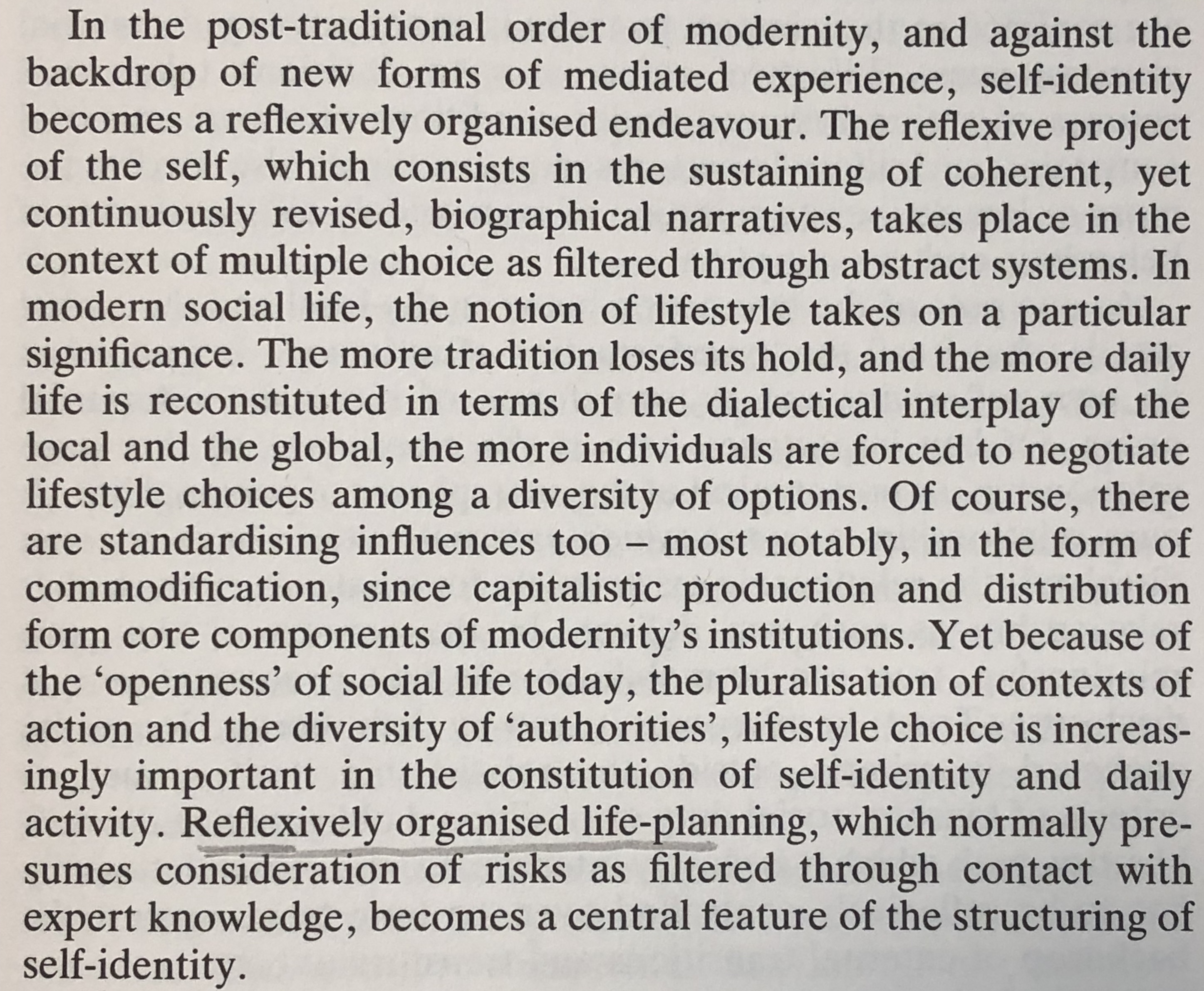
here is an edited version:
“The reflexive project of the self, which consists of the sustaining of consistent, yet continuously revised, biographical narratives, takes place in the context of multiple choice as filtered through abstract systems. In modern social life, the notion of lifestyle takes on a particular significance. The more tradition loses it hold, and the more daily life is reconstituted . . . the more individuals are forced to negotiate lifestyle choices among a diversity of options. Of course there are standardising influences . . . Yet because of the ‘openess’ of social life today, the pluralisation of contexts of action and the diversity of ‘authorities’, lifestyle choice is increasingly important in the constitution of self-identity and daily activity.”
Can you translate some of his ideas? For example, what is reflexivity? If you need more help you can read this post from my own blog: Representation, Identity & Self
Non-Binary, Intersex, CIS and . . .
Ayesha Tan Jones is a non-binary artist and musician who goes by the stage name ‘YaYaBones’
Once you have thought about this, think about the concept of a ‘non binary identity’. Follow this link to find out more. What does this mean to you? How do you feel about it? What about the concept of CIS? Or Intersex?
Do these concepts help you to understand the idea behind the Maybelline marketing campaign?
Again discuss this with your group of friends, make notes and be prepared to feedback to the rest of the class.
So how is the traditional male representation adjusting to this new world from the perspective of Advertising & Marketing?

